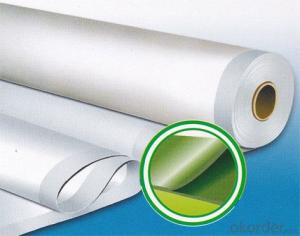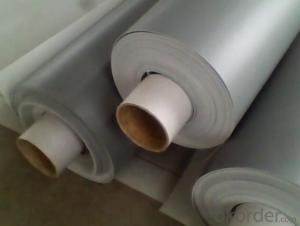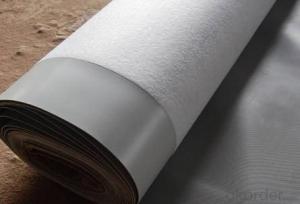PVC Waterproofing Sheet in Polyester Reinforcement with Custom Thickness
- Loading Port:
- Shanghai
- Payment Terms:
- TT OR LC
- Min Order Qty:
- 20000 m²
- Supply Capability:
- 5000000 m²/month
OKorder Service Pledge
OKorder Financial Service
You Might Also Like
PVC Waterproofing Sheet in Polyester Reinforcement with Custom Thickness
Product Description of PVC Waterproofing Sheet in Polyester Reinforcement with Custom Thickness:
PVC Membrane Waterproof /Waterproofing membrane For Roof is a new polymer waterproof membrane. The PVC Membrane Waterproof /Waterproofing membrane For Roof raw material is polyvinyl chloride resin, mixed with plasticizer, filler, antioxygen, ultraviolet absorber and other auxiliaries.
Thickness: 1.2mm/1.5mm/1.8mm/2.0mm
Width:2050mm
Length:20m( Special specifications can be customized)
Size: 2.05mx20m
Color: white/grey, or any other colors.
Features of PVC Waterproofing Sheet in Polyester Reinforcement with Custom Thickness:
1. Excellent anti-aging property.
2. Puncture- resistant.
3. Welding construction,
4. High tensile strength, good elongation, good dimensional stability.
5. Good plasticity.
6. It has self-extinguishing from fire property.
7. Materials surface is smooth, fast color, stain resistance.
8. More wide, Wastage become less when being used.
Classification of PVC Waterproofing Sheet in Polyester Reinforcement with Custom Thickness:
1. N: Homogeneous PVC membrane
2. L: PVC membrane with fabric backing
3. W: Reinforced PVC membrane
Advantage of PVC Waterproofing Sheet in Polyester Reinforcement with Custom Thickness:
1.) Mixing automation. Apply automatic temperature control automatic time control and automatic feed control.
2.) Extrusion equipment uses twin screw coextrusion. Screw temperature uses computer automatic temperature control system.
3.) Handpiece uses large width didhead extrusion equipment.
4.) Sophisticated three-roller calender equipment. The space between equiment is controlled by automation system.
Technical Data of PVC Waterproofing Sheet in Polyester Reinforcement with Custom Thickness:
No. | Item | Model Ⅱ | |
1 | Tensile Strength Mpa ≥ | 12.0 | |
2 | Elongation at break% ≥ | 250 | |
3 | Shrinkage rate % ≤ | 2.0 | |
4 | Flexibility at low temperature | No crackle at -25oC | |
5 | Water tightness | Watertight | |
6 | Puncture resistance | Watertight | |
7 | Heat aging treatment | Appearance | Free from bubble, crack, cohesion and void |
Change rate of tensile strength % | +20oC | ||
Change rate of elongation at break | |||
Flexibility at low temperature | No crack at -20oC | ||
8 | Chemical corrosion resistance | Change rate of tensile strength % | +20 |
Change rate of elongation at break | |||
Flexibility at low temperature | No crack at -20oC | ||
9 | Artificial weathering | Change rate of tensile strength % | +20 |
Change rate of elongation at break | |||
Flexibility at low temperature | No crack at -20oC | ||
Application of PVC Waterproofing Sheet in Polyester Reinforcement with Custom Thickness:
1) All kinds of roofs, such as steel structure roof, planted roof etc.
2) Underground engineering, such as building basement, subways, tunnels, air raid shelter, etc.
3) Other projects like artificial lake, dam, water reservoir, grain storehouse, etc.
Images of PVC Waterproofing Sheet in Polyester Reinforcement with Custom Thickness:
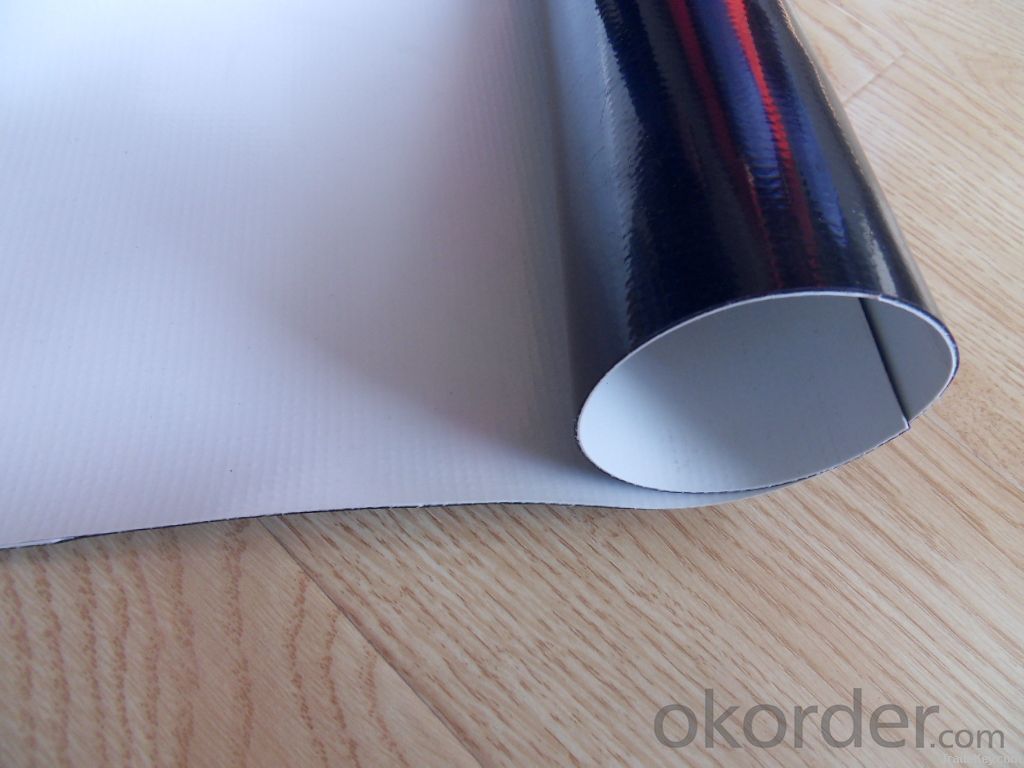
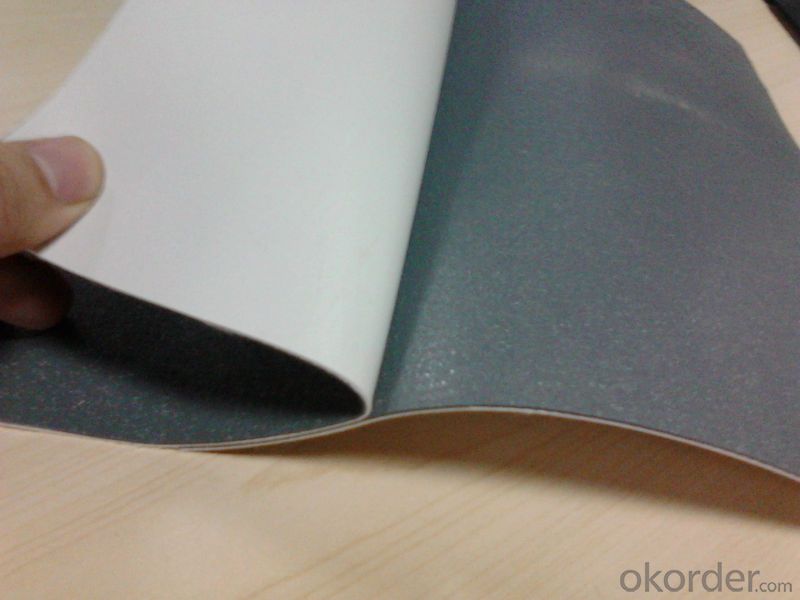
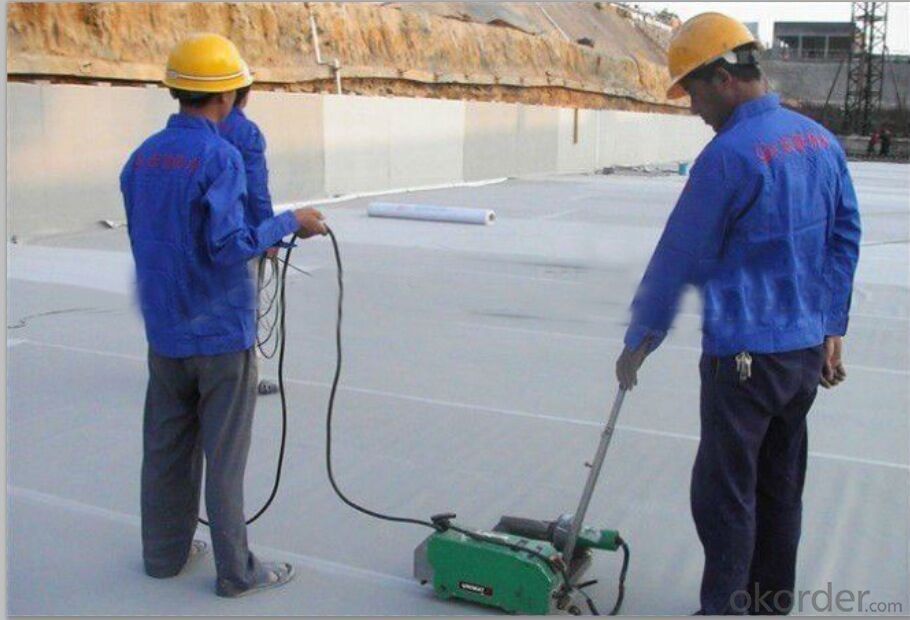

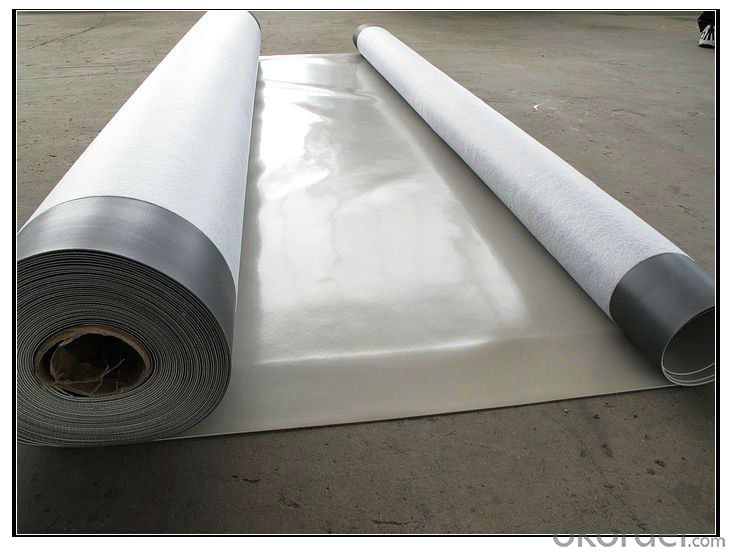
FAQ:
1. Can you produce 4m width?
Yes, no problem for us. We have four bases in China, largest one in this field.
2. How many quantity in one 20'' container for 1.2mm and 1.5mm?
480rolls, 11520m2 for 1.2mm and 400rolls, 9600m2 for 1.5mm
3. Can you provide free samples?
Yes, our samples are free, but express fees usually on buyer's account.
- Q:Can a waterproofing membrane be used in planter boxes or raised beds?
- Yes, a waterproofing membrane can be used in planter boxes or raised beds to prevent water leakage and protect the surrounding structures. A waterproofing membrane is typically made of materials such as rubber, PVC, or polyethylene, which create a barrier between the soil and the surrounding area. This barrier helps retain moisture within the planter box or raised bed, preventing water from seeping into the ground and potentially causing damage to the foundation or nearby structures. Additionally, a waterproofing membrane can also prevent the leaching of chemicals or fertilizers from the soil, improving the overall quality of the planting environment. Nevertheless, it is important to ensure proper drainage in planter boxes or raised beds to prevent waterlogging and root rot.
- Q:Are waterproofing membranes suitable for indoor applications?
- Yes, waterproofing membranes are suitable for indoor applications. They are commonly used in areas such as bathrooms, basements, and kitchens to prevent water damage and moisture penetration. Waterproofing membranes provide an effective barrier against water and can help protect the structural integrity of buildings in indoor environments.
- Q:Can a waterproofing membrane be used in historic buildings?
- Yes, a waterproofing membrane can be used in historic buildings. Historic buildings often face challenges related to moisture infiltration and water damage due to their age and construction materials. Waterproofing membranes are a common solution to prevent water seepage and protect the building's structural integrity. However, it is important to choose a waterproofing membrane that is compatible with the historic building's materials and construction methods to ensure its preservation and adherence to historical authenticity. Additionally, any waterproofing work done on a historic building should be carried out by professionals with expertise in historic preservation to ensure proper installation and minimal impact on the building's historical value.
- Q:Can a waterproofing membrane be used for underground fuel storage tanks?
- Underground fuel storage tanks can benefit from the application of a waterproofing membrane. This membrane serves as a barrier, preventing water and moisture from infiltrating the tank and causing corrosion or leaks. Given their underground positioning, these tanks are particularly susceptible to moisture infiltration. By utilizing a waterproofing membrane, the tank's integrity and lifespan are safeguarded through the provision of a sturdy and trustworthy waterproof seal. When selecting a waterproofing membrane for fuel storage purposes, it is vital to opt for one specifically formulated to endure the harsh conditions and chemicals associated with underground fuel storage.
- Q:How does a waterproofing membrane handle water vapor transmission?
- A waterproofing membrane serves the purpose of blocking liquid water but also facilitates the movement of water vapor. This is made possible through the utilization of certain materials and technologies that enable the membrane to allow the passage of vapor. Water vapor transmission involves the transportation of water molecules in vapor form across a substance. For waterproofing membranes, it is vital to ensure that water vapor can exit the structure to prevent the accumulation of moisture and potential damage. Different types of waterproofing membranes exist, each with its own approach to managing water vapor transmission. Some membranes employ microporous materials that contain small pores or perforations, enabling the passage of water vapor while still preventing liquid water from entering. Other membranes may integrate special coatings or treatments that enhance their vapor transmission capabilities. These coatings assist in regulating the flow of water vapor, enabling it to traverse the membrane while maintaining an effective barrier against liquid water. In addition, advanced waterproofing membranes may incorporate built-in systems for managing moisture. These systems actively monitor and adjust the flow of vapor based on the environmental conditions, ensuring optimal moisture control within the structure. It is important to acknowledge that the effectiveness of a waterproofing membrane in handling water vapor transmission depends on various factors, including the membrane type, installation process, and specific environmental conditions. Proper installation, including the use of appropriate adhesives and sealants, is essential to preserve the membrane's ability to transmit vapor. Overall, the primary function of a waterproofing membrane is to allow the passage of water vapor while simultaneously providing reliable protection against liquid water infiltration. Through the utilization of diverse technologies and materials, these membranes contribute to maintaining a dry and moisture-free environment within a structure.
- Q:Are waterproofing membranes flexible?
- Yes, waterproofing membranes are typically flexible. They are designed to be able to expand and contract with the building materials they are applied to, ensuring a tight and secure seal to prevent water penetration.
- Q:Can a waterproofing membrane be used for an underground structure?
- Yes, a waterproofing membrane can be used for an underground structure. A waterproofing membrane is a protective layer that is designed to prevent the penetration of water into a structure. It is commonly used on roofs, basements, and other areas that are prone to water infiltration. When used in an underground structure, such as a basement or foundation, a waterproofing membrane serves as a barrier against water that may be present in the surrounding soil or groundwater. It helps to prevent water seepage, which can cause damage to the structure and lead to issues such as mold growth or structural deterioration. The waterproofing membrane is typically applied to the exterior walls and the foundation of the underground structure to provide a watertight seal. It is important to select a high-quality membrane that is specifically designed for underground use and meets the necessary industry standards. Additionally, proper installation techniques, including surface preparation and sealing of seams, are crucial to ensure the effectiveness of the waterproofing membrane in an underground structure.
- Q:Can a waterproofing membrane be used on precast plastic surfaces?
- Precast plastic surfaces can indeed benefit from the use of a waterproofing membrane. These membranes serve the purpose of establishing a shield against moisture and can be utilized on various surfaces such as concrete, metal, and plastic. By correctly implementing a waterproofing membrane, water infiltration is prevented, thus guaranteeing the long-lasting and resilient nature of the precast plastic surface. To ensure proper adhesion and effectiveness, it is crucial to select a waterproofing membrane that is compatible with plastic and adhere to the guidelines provided by the manufacturer during application.
- Q:Can a waterproofing membrane be used for a basement wall?
- Yes, a waterproofing membrane can definitely be used for a basement wall. In fact, it is highly recommended to use a waterproofing membrane on basement walls to prevent water infiltration and potential damage. Basement walls are particularly vulnerable to moisture due to their below-ground location, and a waterproofing membrane provides an effective barrier against water penetration. This membrane is typically applied to the exterior side of the basement wall, creating a protective layer that keeps the basement dry and prevents water from seeping into the foundation. It is essential to ensure proper installation and maintenance of the waterproofing membrane to effectively safeguard the basement from water-related issues such as leaks, mold, and structural damage.
- Q:Can a waterproofing membrane be applied over existing waterproofing layers?
- Yes, a waterproofing membrane can be applied over existing waterproofing layers. However, it is important to assess the condition of the existing layers to ensure they are sound and can provide a proper substrate for the new membrane. Additionally, proper surface preparation and compatibility between the existing layers and the new membrane should be considered to ensure a successful and long-lasting waterproofing system.
1. Manufacturer Overview |
|
|---|---|
| Location | |
| Year Established | |
| Annual Output Value | |
| Main Markets | |
| Company Certifications | |
2. Manufacturer Certificates |
|
|---|---|
| a) Certification Name | |
| Range | |
| Reference | |
| Validity Period | |
3. Manufacturer Capability |
|
|---|---|
| a)Trade Capacity | |
| Nearest Port | |
| Export Percentage | |
| No.of Employees in Trade Department | |
| Language Spoken: | |
| b)Factory Information | |
| Factory Size: | |
| No. of Production Lines | |
| Contract Manufacturing | |
| Product Price Range | |
Send your message to us
PVC Waterproofing Sheet in Polyester Reinforcement with Custom Thickness
- Loading Port:
- Shanghai
- Payment Terms:
- TT OR LC
- Min Order Qty:
- 20000 m²
- Supply Capability:
- 5000000 m²/month
OKorder Service Pledge
OKorder Financial Service
Similar products
New products
Hot products
Related keywords
